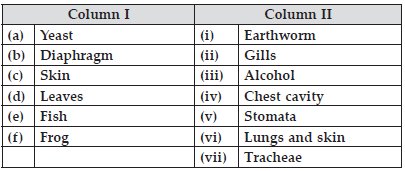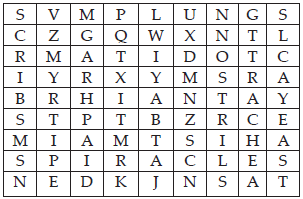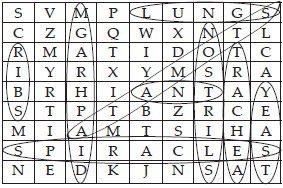Respiration (Biology) Class 7 - NCERT Questions
Why does an athlete breathe faster and deeper than usual after finishing the race?
SOLUTION:Our body needs energy for all activities, which is provided by oxidation of food during respiration. During intense physical activities like running, there is larger demand of energy to perform these activities. Hence, more oxygen is required to meet this extra demand of energy. Therefore, an athlete breathes faster and deeper than usual after finishing the race so as to provide extra oxygen and hence extra energy to the body.
Q 2.List the similarities and differences between aerobic and anaerobic respiration.
SOLUTION:Similarities : In both the types of respiration, food (glucose) is broken down and energy is released. Differences between aerobic and anaerobic respiration are:

Why do we often sneeze when we inhale a lot of dust-laden air?
SOLUTION:When we inhale dust-laden air, dust particles are captured by the hair of the nostrils. Sometimes, they get past the nostril hair in the nasal cavity, and irritate the lining of the cavity. As a result we sneeze. Sneezing expels these foreign particles from the inhaled air so that dust free, clean air enters our body.
Q 4.Take three test-tubes. Fill 3/4-th of each with water. Label them A, B and C. Keep a snail in test-tube A, a water plant in test-tube B and in C, keep snail and plant both. Which test-tube would have the highest concentration of CO2?
SOLUTION:Test tube A will have highest concentration of carbon dioxide. The experiment shows the relationship between plants and animals with respect to gaseous exchange. During breathing, the snail in test tube A, inhales dissolved oxygen from water and releases carbon dioxide. The water plant in test tube B performs another important function of photosynthesis along with respiration. During photosynthesis, water plant absorbs carbon dioxide, prepares food and releases oxygen. In test tube C, carbon dioxide released by snail during respiration is absorbed by plant during photosynthesis. Therefore, tubes B and C have less amount of carbon dioxide concentration as compared to test tube A.
Q 5.Tick the correct answer :
(A) In cockroaches, air enters the body through
(i) lungs (ii) gills (iii) spiracles (iv) skin
(B) During heavy exercise, we get cramps in the legs due to the accumulation of
(i) carbon dioxide (ii) lactic acid (iii) alcohol (iv) water
(C) Normal range of breathing rate per minute in an average adult person at rest is
(i) 9–12 (ii) 15-18 (iii) 21-24 (iv) 30-33
(D) During exhalation, the ribs
(i) move outwards (ii) move downwards
(iii) move upwards (iv) do not move at al



Match the items in Column I with those in Column II:

(A)- (iii), (B)-(iv), (C)-(i), (D)-(v), (E)-(ii), f-(vi)
Q 7.Mark ‘T’ if the statement is true and ‘F’ if it is false:
(i) During heavy exercise the breathing rate of a person slows down. (T/F)
(ii) Plants carry out photosynthesis only during the day and respiration only at night. (T/F)
(iii) Frogs breathe through their skins as well as their lungs. (T/F)
(iv) The fishes have lungs for respiration. (T/F)
(v) The size of the chest cavity increases during inhalation. (T/F)
(i) F - During heavy exercise, more oxygen is required to meet extra demand of energy. Therefore, breathing rate increases.
(ii) F - Photosynthesis occurs in the presence of sunlight and thus takes place only during the day. Respiration is a continuous process and occurs all the time (day and night).
(iii) T
(iv) F - Fishes breathe through gills.
(v) T
Given below is a square of letters in which are hidden different words related to respiration in organisms. These words may be present in any direction— upwards, downwards, or along the diagonals. Find the words for your respiratory system. Clues about those words are given below the square.
Clues:
(i) The air tubes of insects
(ii) Skeletal structures surrounding chest cavity
(iii) Muscular floor of chest cavity
(iv) Tiny pores on the surface of leaf
(v) Small openings on the sides of the body of an insect
(vi) The respiratory organs of human beings
(vii) The openings through which we inhale
(viii) An anaerobic organism
(ix) An organism with tracheal system

(i) Trachea
(ii) Ribs
(iii) Diaphragm
(iv) Stomata
(v) Spiracles
(vi) Lungs
(vii) Nostrils
(viii) Yeast
(ix) Ant

The mountaineers carry oxygen with them because:
(A) At an altitude of more than 5 km there is no air.
(B) The amount of air available to a person is less than that available on the ground.
(C) The temperature of air is higher than that on the ground.
(D) The pressure of air is higher than that on the ground.
